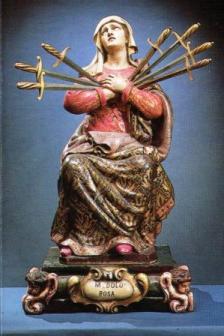 Today is the Seven Sorrows of the Blessed Virgin Mary. Can you name them?
Today is the Seven Sorrows of the Blessed Virgin Mary. Can you name them?
Here the entry from the Roman Martyrology:
Memoria beatae Mariae Virginis perdolentis, quae, iuxta crucem Iesu adstans, Filii salutiferae passioni intime fideliterque sociata est et nova exstitit Eva, ut, quemadmodum primae mulieris inoboedientia ad mortem contulit, ita mira eius oboedientia ad vitam conferret.
In the older, pre-Conciliar Missale Romanum we find this wonderful Collect for today’s Holy Mass.
COLLECT (1962MR):
Deus, in cuius passione,
secundum Simeonis prophetiam
dulcissimam animam gloriosae Virginis Matris Mariae
doloris gladius pertransivit:
concede propitius;
ut qui dolores eius venerando recolimus,
passionis tuae effectum felicem consequamur.
LITERAL VERSION:
O God, at whose Passion,
according to Simeon’s prophecy,
the most sweet soul of the glorious Virgin, Mary our Mother,
was pierced by a sword of sorrow:
mercifully grant
that we who observe her sorrows by veneration
may attain to the happy result of Your Passion.
 Also, in the old Communion Antiphon we have a connection between the great sorrow of Mary at the Cross and how she merits to be called Queen of Martyrs:
Also, in the old Communion Antiphon we have a connection between the great sorrow of Mary at the Cross and how she merits to be called Queen of Martyrs:
ANTIPHONA AD COMMUNIONEM:
Felices sensus beatae Mariae Virginis,
qui sine morte meruerunt martyrii palmam
sub Cruce Domini.
Sensus is an incredibly complicated word. It means, among other things, the faculties of sensing and perceiving, but also of the sentiments of the heart and mind. In a collective “sense” sensus stands for “the common feelings of humanity, the moral sense”. Sensus is also our disposition of mind or humor and inclination. It signifies understanding of the thinking faculty, in the sphere of reason.
LITERAL VERSION:
Blissful the sentiments of the Blessed Virgin Mary,
which beneath the Cross of the Lord,
without death merited the martyr’s palm.
This antiphon underscores how the totality of Mary’s being, “magnified” by God at every point of her life, was united with her Son as He endured the sufferings of the Cross.
This feast reminds us that there is a path to holiness through the sufferings and sorrows we endure. We must learn to unite them to the sufferings of our Lord. Mary teaches us to do this. The martyrs teach us to do this.
Here is something that I wrote for the best Catholic weekly in the UK, the Catholic Herald in my column “Omnium Gatherum”:
September brings lovely Marian feasts, including – in the traditional Roman calendar – Our Lady of the Good Shepherd (3 Sept), Nativity of Mary (8), Name of Mary (12), Seven Sorrows of Mary or Our Lady of Sorrows (15), Our Lady of Ransom (24).
The feast of the Our Lady of Sorrows was instituted in Cologne in 1413 as a response to the Protestant Hussites (the ones that put the sword gashes on the face of Our Lady of Czestochowa in Poland). Pope St Pius X assigned her feast to 15 September 15 so she could remain close to the Cross and the Feast of its Exaltation on 14 September.
Our Lady’s Seven Sorrows are 1) The Prophecy of Holy Simeon, 2) The Flight of the Holy Family into Egypt, 3) The Loss of the Child Jesus in the Temple, 4) The Encounter of Jesus with His Blessed Mother as He Carries the Cross, 5) The Crucifixion and Death of our Lord Jesus Christ and Mary at the foot of the Cross, 6) The Descent from the Cross, and Jesus in the Arms of His Most Blessed Mother, 7) The Burial of our Lord, and the Loneliness of the Blessed Virgin.
Speaking of seven, Our Lady revealed to St Bridget (d 1373) a devotion we can use to obtain seven graces if we meditate on her sorrows and recite seven Hail Mary’s. These graces are (in her voice) 1) I will grant peace to their families, 2) They will be enlightened about the divine mysteries, 3) I will console them in their pains and I will accompany them in their work, 4) I will give them as much as they ask for as long as it does not oppose the adorable will of my divine Son or the sanctification of their souls, 5) I will defend them in their spiritual battles with the infernal enemy and I will protect them at every instant of their lives, 6) I will visibly help them at the moment of their death, they will see the face of their Mother, 7) I have obtained from my divine Son, that those who propagate this devotion to my tears and sorrows, will be taken directly from this earthly life to eternal happiness since all their sins will be forgiven and my Son and I will be their eternal consolation and joy.
Our beautiful devotions enrich our lives.


































I love the Seven Dolors Rosary. In the last 4 years I believe I have only missed less than 5 days saying it. (and that was mainly because I fell asleep).
Yesterday for the Exaltation of the Cross we got permission from the local pastor and the Chancery to celebrate a low Mass at a small private chapel. We never advertise it but the chapel was packed. We then recited the Stations of the Cross on the way up a steep hill to where a huge Cross was erected about 20 years ago. Beautiful weather, great people (and tired), finished the day with a potluck back on the chapel grounds.
Today, novus ordo Mass: the prayer after communion was puzzling to me. I think it said something about the imperfect suffering of Christ. I don’t understand. Can anyone explain?
“Having received the Sacrament of eternal redemption, we humbly ask, O Lord, that, honoring how the Blessed Virgin Mary suffered with her Son, we may complete in ourselves for the Church’s sake what is lacking in the sufferings of Christ. Who lives etc. …”
I’m thinking “what is lacking” refers back to “complete in ourselves for the Church’s sake” rather than “the sufferings of Christ”. But we would probably have to go back to the original Latin to confirm that. What does the prayer really say?
Thank you! I had never heard of this. You instructed the ignorant. :)
facta non verba, it’s clearly a reference to Colossians 1:24.
“24 Now I rejoice in what I am suffering for you, and I fill up in my flesh what is still lacking in regard to Christ’s afflictions, for the sake of his body, which is the church.” NIV, though we are used to the sound of the RSV, which I was too tired to look up.
jonpatrick, the sufferings of Christ are not complete because the sufferings of the martyrs and other people need to be added to them.
The MR 2002 version of the collect is: “Deus, qui Fílio tuo in cruce exaltáto compatiéntem Matrem astáre voluísti, da Ecclésiæ tuæ, ut, Christi passiónis cum ipsa consors effécta, eiúsdem resurrectiónis párticeps esse mereátur.” (O God, who willed that, when your Son was lifted high on the Cross, his Mother should stand close by and share his suffering, grant that your Church, participating with the Virgin Mary in the Passion of Christ, may merit a share in his Resurrection.)
I think it’s a good enough prayer, certainly, but why did they have to change it so radically from the previous? Not getting hung up on this, of course – in fact, how great that the Feast wasn’t just dropped altogether! – but I still can’t see why they had to change it wholesale. Well, maybe one can guess. Was it perhaps because they were embarrassed at the explicit Catholicism of phrases like “dulcissimam animam gloriosae…”? The current version is much more sparse in reference to Her. But… how good that we still have the Feast.
Yes, the Seven Sorrows devotion is beautiful. I must make more frequent use of it.
My thanks to all for the helpful comments.